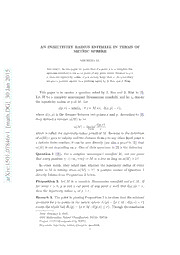
An injectivity radius estimate in terms of metric sphere PDF
Preview An injectivity radius estimate in terms of metric sphere
AN INJECTIVITY RADIUS ESTIMATE IN TERMS OF METRIC SPHERE SHICHENGXU Abstract. In this paper we provethat if a point p in a complete Rie- 5 1 mannianmanifold isnotacutpointofanypointwhosedistancetopis 0 r,thentheinjectivityradiusofpisstrictly large thanr. Asacorollary 2 we give a positive answer to a problem raised byZ. Sun and J. Wan. n a J This paper is to answer a question asked by Z. Sun and J. Wan in [2]. 0 3 Let M be a complete noncompact Riemannian manifold, and let i denote p the injectivity radius at p of M. Let ] G i(p,r) = min{i :∀x ∈ M s.t. d(x,p) = r}, D x h. where d(x,p) is the distance between two points x and p. According to [2], at they defined a number α(M) to be m i(p,r) [ α(M) = liminf , r→∞ r 1 which is called the injectivity radius growth of M. Because in the definition v 6 of α(M) r goes to infinityand thedistancefrom pto any other fixed pointis 4 a definite finite number, it can be seen directly (see also a proof in [2]) that 8 7 α(M) is not depending on p. One of their questions in [2] is the following 0 . Question 1 ([2]). For a complete noncompact manifold M, can one prove 1 0 that every geodesic γ : (−∞,+∞)→ M is a line as long as α(M) > 1? 5 1 In other words, they asked that whether the injectivity radius of every : v point in M is infinity when α(M) > 1? A positive answer of Question 1 i X directly follows from Proposition 2 below. r a Proposition 2. Let M be a complete Riemannian manifold and p ∈ M. If for some r > 0, p is not a cut point of any point x such that d(x,p) = r, then the injectivity radius i at p >r. p Remark 3. Thepoint in proving Proposition 2 is to show that theminimal geodesics for p to points in the metric sphere S (p) = {x ∈ M :d(p,x) = r} r covers thewholeballB (p)= {x ∈ M : d(p,x) ≤ r}. Thoughtheconclusion r Date: February 2, 2015. 2000 Mathematics Subject Classification. 53C20. 53C35. Project 11171143 supported byNSFC. Keywords: Injectivity radius, Complete manifold. 1 AN INJECTIVITY RADIUS ESTIMATE IN TERMS OF METRIC SPHERE 2 of Proposition 2 may be already known by some experts, it seems that it is still not well-known and there is no proof can be found in the earlier literature. That is the reason why I decided to write down a proof. Remark 4. It can be proved that for p ∈ M and r > 0, if the minimizing geodesic from p to each point x such that d(x,p) = r is unique, then the injectivity radius of p ≥ r. However, the proof is more complicate than that of Proposition 2. So we will not go into that case here. Proof of Proposition 2. Let T1M denote the set of all unit vectors at p in p M. Let us denote A(p,r) = {X ∈ T1M : exp (tX) is minimal on [0,r′) for some r′ > r}. p p It suffices to show that A(p,r) is open and close in T1M. Firstly, it is p well-known that the function σ : T1M → R+, p σ(X) = sup{t :exptX is minimal on [0,t]}, is continuous (see 2.1.5 Lemma in [1]). Hence by definition A(p,r) is open. Now let usshow thatA(p,r)is closed inT1M. Assumeasequenceof unit p vectors X ∈ A(p,r) converges to a unit vector X ∈ T1M, then the geodesic i p exp(tX ) converges to exp(tX) point-wisely. Because all geodesic exp(tX ) i i is minimal on [0,r], the limit exp(tX) is also a minimal geodesic on [0,r], and thus d(exp(rX),p) = r. Moreover, by the assumption of Proposition 2, exp(rX) is not a cut point of p. Hence, there is ǫ > 0 such that exp(tX) is also minimal on [0,r+ǫ]. Thus X ∈A(p,r) and A(p,r) is closed. Because A(p,r) is open and closed, it coincides with T1M. Therefore the p injectivity radius at p is > r. (cid:3) The following corollaries directly follows from Proposition 2. Recall that p is called a pole if the injectivity radius of p is infinity. In particular, M is diffeomorphic to Rn by the exponential map exp : T M → M at a pole. p p Corollary 5. Let M be a complete non-compact manifold. M possesses a pole at p if ( and only if ) there is a sequence r → ∞ such that p is not a k cut point of any point in S(p,r ). k Corollary 6. i(p,r) limsup > 1, r→∞ r implies that every point in M is a pole. Hence either limsupr→∞ i(pr,r) ∈ [0,1], or limsupr→∞ i(pr,r) =∞. Becauseα(M) ≤ limsupr→∞ i(pr,r),Corollary6notonlyanswersQuestion 1, but also strength the homeomorphism result of Theorem 1.2 in [2] to diffeomorphism in the case of dimension 4. AN INJECTIVITY RADIUS ESTIMATE IN TERMS OF METRIC SPHERE 3 Acknowledgement TheauthorthanksZhongyangSunforthediscussiontobringtheauthor’s attention totheproblem,andalsothanksJianmingWanforhisinterestthat gave the author motivation to complete this note. References [1] W. Klingenberg. Riemannian Geometry. De Gruyter studies in mathematics. Walter de Gruyter,Berlin, 1982. [2] Z.SunandJ.Wan.Ontheinjectivicyradiusgrowthofcompletenoncompactriemann- ian manifolds. Asian J. Math., 18(3):419–426, 2014. E-mail address: [email protected] SchoolofMathematicalSciences,CapitalNormalUniversity,Beijing,China
